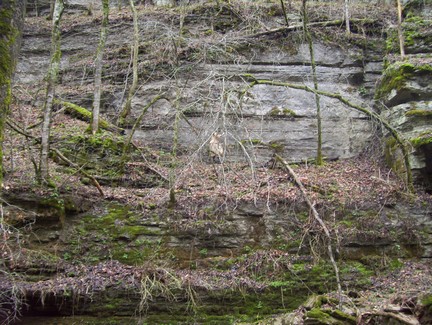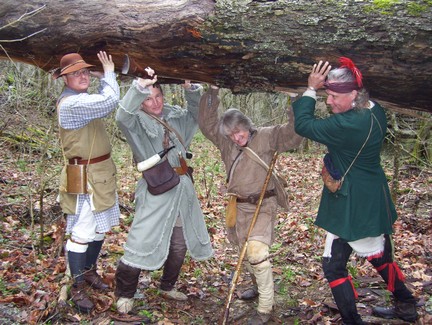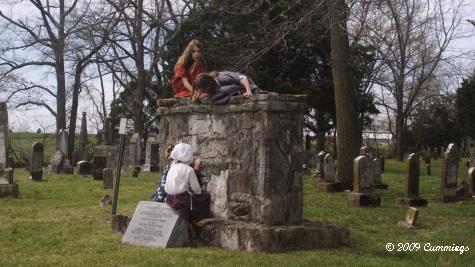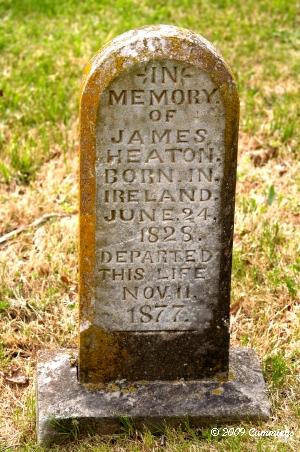|
|
 |
 |
|
In their Footsteps ... Trekking along Marble Creek
|
 |
 |
 |
 |
 |
 |
 |
 |
 |
 |
 |
 |
 |
|
Along Marble Creek
|
|
|
|
By Kristi Heasley
|
|
|
|
We set up our camps on Friday and despite evening rain built a fire and cooked a big meal of beef, pork, squash and sweet potatoes. We spent the evening under the fly with some adult beverages, good conversation, and the companionship of two dogs -Michael's beagle, Shelby, and our Jack Russell, Bitsy.
We cooked a big breakfast on Saturday morning and prepared for our trek to the Kanta-ke River. We were joined by Tommy Barnett and Tony Richardson and set out about 10:30 a.m.
|
|
|
Because the creek was up from rain during the week, we had a hard time finding a good place to cross and start our journey. So not 5 minutes into the adventure, we were peeling off stockings, leggins', shoes, moccasins, etc. We had to zig zag back and forth from one side of the creek to the next to maneuver the terrain, and in some cases part of the party took one route and part took another, just to see which way was the most efficient.
After at least 3 or 4 crossings in bare feet and taking the time to redon stockings and shoes, we started walking right through the water with no regard for our footwear or feet.
|
|
|
 |
|
|
|
After some photos, we started back the way we came. Back on top the ridge, we stopped to energize with apples and oranges and some water and then started back down. We retraced our path all the way back to our camp and then had a rest and dried our feet.
|
|
|
|
 |
|
|
|
Still keeping their sense of humor despite the tough climb are Scott Heasley, Tommy Barnett, Tony Richardson and Michael Fields.
|
|
|
|
 |
 |
|
We will try to make this an annual event and possibly do another hike when the weather changes and the water level is down a bit. I myself want to try it next time barefooted. For I could not shake the image of Mary Ingles going home when I was climbing up and down and thinking about how uncomfortable I was. And I had the benefit of a good meal in my belly and modern hiking boots. I am in awe of her journey and cannot fathom the endurance it took to do what she did.
|
|
|
 |
 |
|
Editor’s note:
Thanks to Kristi and Scott Heasley for sending their photos of the trek on Marble Creek. Much of the early history of Kentucky revolves around the area along the Kentucky River. And sometimes if you are not familiar with the area you do not realize just how much of an impact the palisades had on that early history. Today, modern bridges cross the Kentucky River. But for the early settlers the high walls of the palisades actually dictated such things as where the original Fort
|
|
|
 |
 |
|
Boonesborough was built, how the Boone’s traveled to Boone’s Station and how you fled from Indians. The Palisades encompass about 100 miles of the riverbank - stretching from Clays Ferry in Madison County to Frankfort in Franklin County.
|
 |
 |
|
A Visit to The Red River Meeting House
|
 |
 |
 |
|
 |
 |
 |
 |
 |
 |
 |
 |
 |
 |
 |
 |
|
In addition to the meeting house the cemetery holds a vast amount of early history. It includes graves of Revolutionary War soldiers and also from The French and Indian War, The War of 1812, The Civivl War, The Spanish American War and even a soldier who was at The Battle of Waterloo.
|
|
|
|
The Building
- Original Log Church ”tumbled down” in 1865 from age.
- The Second Church on the spot was the Red River Cumberland Presbyterian Church 1847 - 1935
- First replica church was built in 1959 using hand hewn logs. Was destroyed by fire in 1992
- Second replica church (present structure) completed in 1994
|
|
|
 |
|
|
|
|
|
 |
|
|
|
|
 |
|
|
|
|
|
|
Part of the original structure still stands. During our visit a group of girls had gathered on the structure, feeling the old stones and studying its cracks and crevices.
|
|
|
|
|
|
The Red River Meeting House was the site of the Second Great Awakening in 1800. On the early frontier, formal religion was slow to take hold. As late as 1820 only one out of twelve Kentuckians were church members. But according to “A History of the South” by Francis Butler Simpkins “Between 1797 and 1805, the frontier was swept by a religious revival whose effects were so widespread the the movement has been called The Second Awakening. It began in Logan County, Kentucky.
|
|
|
|
|
|
This Second Great Awakening, a reprise of the Great Awakening of the early 18th century, was marked by an emphasis on personal piety over schooling and theology. It arose in several places and in several active forms. In northern New England, social activism took precedence; in western New York, the movement encouraged the growth of new denominations. In the Appalachian region of Tennessee and Kentucky, the revival energized Presbyterians, Methodists and Baptists, and gave rise to the popular camp meeting, a chance for isolated frontier folk to gather and enjoy the excitement of evangelistic fervor. The first camp meeting occurred in south-central Kentucky in June 1800. James McGready, a Presbyterian, and two colleagues preached for three solid days. The following day, two circuit-riding Methodist ministers arrived and emotionally exhorted the crowd. The revivals of the west were much more emotional than those in the east.
|
|
|
|
 |
 |
|
Information for this story was obtained from literature on site and with help from The Red River Meeting House and Cemetery Association.
|
 |
|
|
 |
|
|
 |
 |
 |
 |
|
Home Country - A book for today and yesterday
|
|
|
|
April 18, 1945 marked the death of one of the World’s most well known newspaper columnists - Ernie Pyle.
Pyle was born in 1900 in Dana, Indiana. He went on to attend Indiana University and later to become a well known columnist for Scripps Howard newspapers. He is most remembered for his columns from the front lines in Europe during World War II.
But click here to read a book review of Home Country a compilation of Pyle’s columns from the Great Depression. It is a great book for reading today. The tough economic times of 2009 are no comparison for that era.
|
|
|
|
|